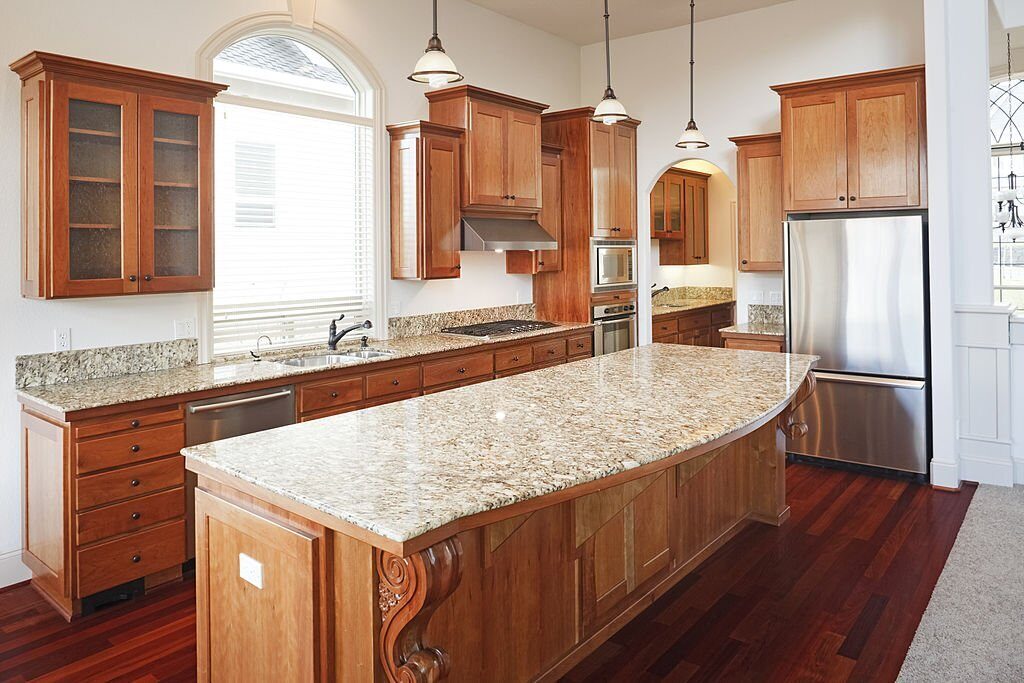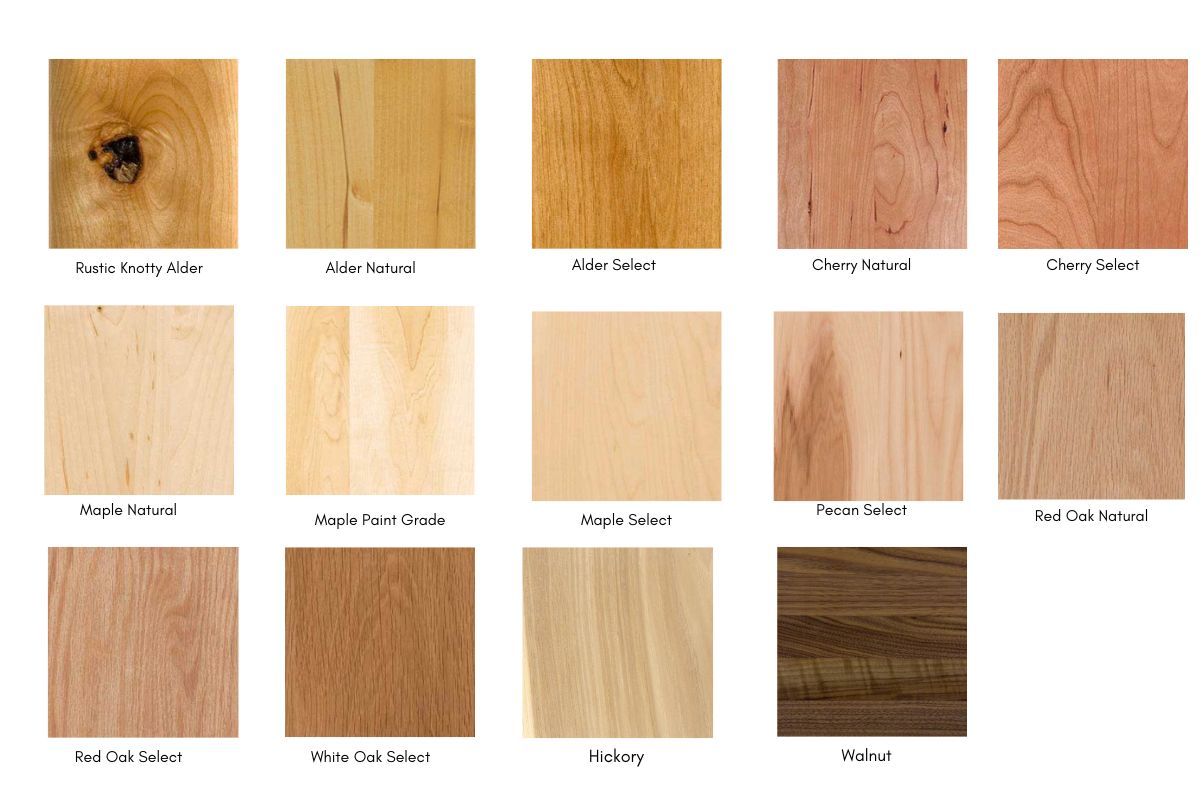Walnut vs. Cherry

Choosing the right wood for your kitchen cabinets is a crucial decision that impacts both the aesthetics and functionality of your space. Walnut and cherry are popular choices, each offering distinct characteristics and visual appeal. Understanding their unique qualities will help you make an informed choice that aligns with your design preferences and lifestyle.
Wood Characteristics and Aesthetics, Walnut vs cherry kitchen cabinets
Walnut and cherry wood possess distinctive grain patterns and color variations that contribute to their unique aesthetic appeal. Walnut wood is renowned for its rich, dark brown hues, often featuring prominent, swirling grain patterns that create a dramatic and sophisticated look. The color of walnut wood can range from light brown to deep chocolate, with variations in color intensity depending on the specific species and region of origin.
Cherry wood, on the other hand, exhibits a warm, reddish-brown tone with a more subtle grain pattern. Its color tends to deepen and become more reddish over time, developing a beautiful patina that enhances its natural beauty. Cherry wood is often described as having a classic, elegant appeal, making it a popular choice for traditional and contemporary kitchen designs.
Durability and Hardness
Walnut and cherry wood are both known for their durability and strength, making them suitable for high-traffic areas like kitchens. However, walnut wood is slightly harder and more resistant to scratches and dents than cherry wood. This inherent strength makes walnut a preferred choice for high-use areas where the cabinets may experience frequent contact and wear.
The Janka hardness scale measures the resistance of wood to denting and abrasion. Walnut wood scores around 1010 on the Janka scale, while cherry wood scores around 995. This slight difference in hardness indicates that walnut wood is slightly more resistant to denting and scratches, making it a more durable option for high-traffic areas.
Natural Finishes
The natural finishes applied to walnut and cherry wood cabinets can significantly enhance their aesthetic appeal and protect their surface. Walnut wood’s rich, dark tones are often complemented by natural oil finishes that allow the wood’s natural beauty to shine through. Oil finishes create a warm, satin-like sheen that highlights the wood’s grain patterns and depth of color.
Cherry wood’s warm reddish-brown tones are well-suited to a variety of finishes, including oil-based stains, varnishes, and lacquers. These finishes can enhance the wood’s natural color and create a smooth, protective layer that protects the surface from scratches and stains.
Pros and Cons of Walnut and Cherry Cabinets
| Feature | Walnut | Cherry |
|---|---|---|
| Color | Rich, dark brown with prominent grain patterns | Warm, reddish-brown with subtle grain patterns |
| Durability | Harder and more resistant to scratches and dents | Durable but slightly softer than walnut |
| Aesthetics | Dramatic, sophisticated, and modern | Classic, elegant, and timeless |
| Cost | Generally more expensive | Moderately priced |
| Maintenance | Requires regular oiling to maintain its finish | Requires regular cleaning and occasional refinishing |
Kitchen Design Considerations

The choice between walnut and cherry cabinets goes beyond aesthetics; it influences the overall design direction of your kitchen. Each wood possesses unique characteristics that can dramatically impact the space’s ambiance and style.
Kitchen Styles and Wood Choices
The inherent qualities of walnut and cherry make them ideal for specific kitchen styles.
- Walnut, with its rich, dark hues and bold grain patterns, complements modern and contemporary kitchens. Its dramatic presence adds a touch of sophistication and warmth to sleek, minimalist designs.
- Cherry, with its warm, reddish tones and fine grain, lends itself beautifully to traditional and farmhouse styles. Its elegant yet inviting character creates a sense of comfort and timeless appeal.
Color and Grain Influence
The color and grain of walnut and cherry cabinets play a significant role in shaping the kitchen’s ambiance.
- Walnut’s dark, often chocolate-brown color creates a sense of intimacy and depth. Its prominent grain adds visual interest and texture, making the kitchen feel more grounded and substantial.
- Cherry’s warm, reddish-brown tones, often with subtle hints of pink or purple, evoke a sense of warmth and comfort. Its fine grain adds a delicate touch of elegance and sophistication.
Cabinet Door Styles and Aesthetics
The choice of cabinet door style further enhances the visual impact of walnut and cherry cabinets.
- For a contemporary look, consider sleek, flat-panel doors with clean lines and minimal ornamentation. This style complements walnut’s bold grain and dark hues, creating a sophisticated and minimalist aesthetic.
- For a more traditional feel, choose raised-panel doors with intricate detailing. These doors enhance cherry’s elegance and warmth, creating a timeless and classic look.
Kitchen Layouts
The layout of the kitchen can also highlight the beauty of walnut and cherry cabinets.
- In a modern kitchen with a linear layout, walnut cabinets can create a dramatic focal point. The bold grain and dark color will stand out against sleek countertops and minimalist appliances.
- In a farmhouse kitchen with an island layout, cherry cabinets can create a warm and inviting ambiance. The light and airy feel of the island will be complemented by the rich tones and fine grain of the cabinets.
Practical Aspects and Cost: Walnut Vs Cherry Kitchen Cabinets
:max_bytes(150000):strip_icc()/VuoBgokA-5037e35874eb42dc9da70280c249e4c8.jpeg)
When deciding between walnut and cherry kitchen cabinets, practical considerations such as cost, maintenance, and sustainability play a crucial role. Both wood types offer unique benefits and drawbacks, which we will explore in detail below.
Cost Comparison
The cost of walnut and cherry cabinets varies significantly depending on factors like wood quality, cabinet style, and labor costs. Walnut, being a denser and more sought-after wood, generally commands a higher price than cherry. However, the price difference can be influenced by local availability and market fluctuations.
- Walnut: Due to its rarity and durability, walnut is considered a premium wood, often costing 20% to 30% more than cherry. This higher price tag reflects its exceptional strength, distinctive grain patterns, and luxurious appeal. However, availability can fluctuate, impacting the cost.
- Cherry: Cherry wood is more readily available than walnut, making it a more affordable option. It is known for its rich reddish-brown color, smooth texture, and beautiful grain patterns. While less expensive than walnut, cherry still offers a high-quality, aesthetically pleasing option for kitchen cabinets.
Maintenance Requirements
Both walnut and cherry are relatively low-maintenance woods, but they require specific care to preserve their beauty and longevity.
- Walnut: Walnut’s tight grain and natural oils make it resistant to scratches and dents. However, it can be susceptible to moisture damage, so it’s important to avoid excessive exposure to water. Regular cleaning with a soft cloth and mild wood cleaner is recommended. Avoid harsh chemicals and abrasive cleaners.
- Cherry: Cherry wood is known for its smooth texture and rich color, but it can be more susceptible to scratches and dents than walnut. Regular cleaning with a soft cloth and mild wood cleaner is recommended. Applying a sealant or finish can help protect the wood’s surface and enhance its durability.
Sustainability and Environmental Impact
Both walnut and cherry are hardwood species that grow naturally in North America. Their sustainability and environmental impact are crucial considerations for environmentally conscious homeowners.
- Walnut: Walnut trees are slow-growing, but they can live for hundreds of years. Sustainable forestry practices ensure that walnut wood is harvested responsibly, minimizing environmental impact. However, the demand for walnut has increased, leading to concerns about overharvesting in certain regions.
- Cherry: Cherry trees are relatively fast-growing and can be harvested more frequently than walnut. They are also a popular choice for furniture and other wood products, leading to a larger supply and lower environmental impact. Sustainable forestry practices are essential for maintaining healthy cherry populations and ensuring a long-term supply of this beautiful wood.
Pros and Cons of Walnut and Cherry Cabinets
| Feature | Walnut | Cherry |
|---|---|---|
| Cost | Higher | Lower |
| Availability | Less readily available | More readily available |
| Durability | Very durable, resistant to scratches and dents | Durable, but more susceptible to scratches and dents |
| Maintenance | Low maintenance, but requires protection from moisture | Low maintenance, but requires regular cleaning and sealing |
| Sustainability | Sustainable with responsible forestry practices | Sustainable with responsible forestry practices |
| Appearance | Distinctive dark brown color, rich grain patterns | Rich reddish-brown color, beautiful grain patterns |
Walnut vs cherry kitchen cabinets – While walnut and cherry cabinets offer distinct visual appeal, a modern alternative that’s gaining popularity is black granite gray cabinets. This sleek, contemporary look can complement both traditional and minimalist kitchen designs, offering a sophisticated touch that sets it apart from the warmth of walnut or cherry.
Ultimately, the choice between these options depends on your personal style and the overall ambiance you want to create in your kitchen.
Choosing between walnut and cherry kitchen cabinets is a matter of personal preference, with walnut offering a rich, dark tone and cherry a warm, reddish hue. If you’re considering a DIY approach, you might want to explore the options at diy cabinet warehouse ottawa , which offers a wide selection of materials and finishes for your project.
Whether you opt for walnut or cherry, the right cabinet choice can truly elevate the look and feel of your kitchen.
